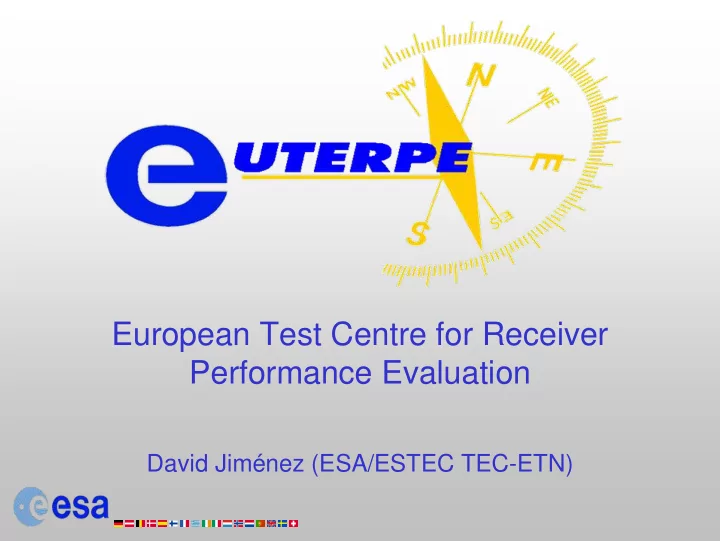

European Test Centre for Receiver Performance Evaluation David Jiménez (ESA/ESTEC TEC-ETN)
• Introduction • Description of current tests • Testing tools • Results • Calibration and results publication • GNSS User Equipment testing covering future modernisations • Conclusions
• Main Objective of EUTERPE will be to: – provide the receiver manufacturers with a “statement of compliance” and in this way – offer them the support needed for the compatibility of the receivers with European GNSS • In an initial phase this centre is being setup at ESTEC within the facilities of the European Navigation Laboratory
• Challenges: 1. Limited availability of information to application designers • Lack of Standardization has translated into a difficult work when comparing receivers 2. Future objective: testing of all kinds of receivers • EUTERPE Approach: 1. Complete Set of Reference Tests 2. Comprehensive and easy-to-compare Review of Rx 3. GPS/EGNOS Rx for non-SoL applications
• Baseline for GPS/EGNOS Rx for non-SoL applications: – Testing of compatibility of the GNSS receivers with the EGNOS system, i.e. proper implementation of EGNOS message processing algorithms • Extension of Tests depending on manufacturers needs: – Positioning errors – Acquisition and tracking thresholds – Performance under interfering scenarios – Multipath and near-far mitigation – Indoor performance – etc.
Test SBAS Purpose Type of result Message • Testing the 1 MT1 PRN Mask assign. and monitored SV. compatibility of Fast corrections Position 2 MT2-5 Fast corrections (Use of PRC /RRC). Position fixes. Rx with EGNOS 3 MT2-5 SV “do not use” / “not monitored”. Position fixes. 2 MT2-5 (Use of PRC and fixes. broadcast from 4 MT2-5 Use of IODP. Position fixes. RRC). and End user 5 MT2-5 Time out of fast corrections. Position fixes. 6 MT6 Satellites set to “do not use” or “not Position fixes. point of view Satellites set to Position monitored”. 7 MT6 Use of IODF. Position fixes. 3 MT2-5 “do not use” or fixes. 8 MT25 Use of slow corrections. Position fixes. • End-To-End “not monitored”. 9 MT25 Use of velocity code. Position fixes. Testing of 10 MT25 Use of IODP. Position fixes. correct 11 MT25 Time out of slow corrections. Position fixes. 12 MT24 Use of mixed fast and slow corrections. Position fixes. algorithms 13 MT18 Ionospheric grid definition. Change in Implicitly taken implementation monitored grid points. care in test 16. to decode the 14 MT26 Use of GIVD. Position fixes. 15 MT26 Grid “do not use” / “not monitored”. Position fixes. EGNOS 16 MT26 USE of IODI. Position fixes. messages 17 MT26 Time out of ionospheric corrections. Position fixes. 18 MT26 Interpolation of IGPs. SV used Pos Fix. 19 MT2-5 Switching GEO Satellites. Position fixes. • Indirect 20 MT2-5 Switching SBAS Operator Position fixes. Algorithm T ti
SBAS logged file Other Egnos file GNSS Euterpe sources tools simulator EMS Receiver Logged data CSV file Data Results Matlab conversion
Spirent PC 1 SimGEN STR4760 software PC 2 Euterpe tools Nav Data Rx under test Converter
6 Fast corrections test x 10 4.715 4.7149 4.7148 4.7147 Baseline Y cartesian position (m) Modified 4.7146 4.7145 4.7144 4.7143 4.7142 4.7141 4.714 4.2444 4.2445 4.2446 4.2447 4.2448 4.2449 4.245 X cartesian position (m) 6 x 10 Mean diff X = 255.73 m Mean diff Y = 820.25 m
• EUTERPE is in an initial phase – Tools and test methodology still under validation – Key element: Collaboration with manufacturers • Tests and results will be discussed with the manufacturers before their publication • Calibration and validation of the equipment and testing tools to achieve consistency – Crosschecking the results – Periodical calibration tests – the STR4760 simulator is tested and calibrated periodically by the manufacturer Spirent communications Ltd.
GNSS User Equipment testing covering future modernisations • Constant evolution of test methodology: – Pegasus Convertor will eventually be discarded in favour of using NMEA messages. • Extension to broader range of receivers – Standalone GPS receivers – Indoor GNSS receivers – Handheld GNSS receivers – Galileo receivers – etc
• Sophisticated tools and a consolidated test strategy is a must for comparing Rx • Reducing human interaction – Eliminate subjectivity (the tests are either a pass or a not pass) • Interaction with manufacturers – Maintain good relations – Remain independent – Identify receivers to test and discussing the results has proven useful for both parties • Galileo receiver testing in the coming years
Thank you for your attention
Recommend
More recommend